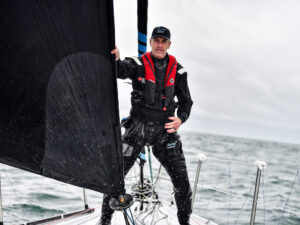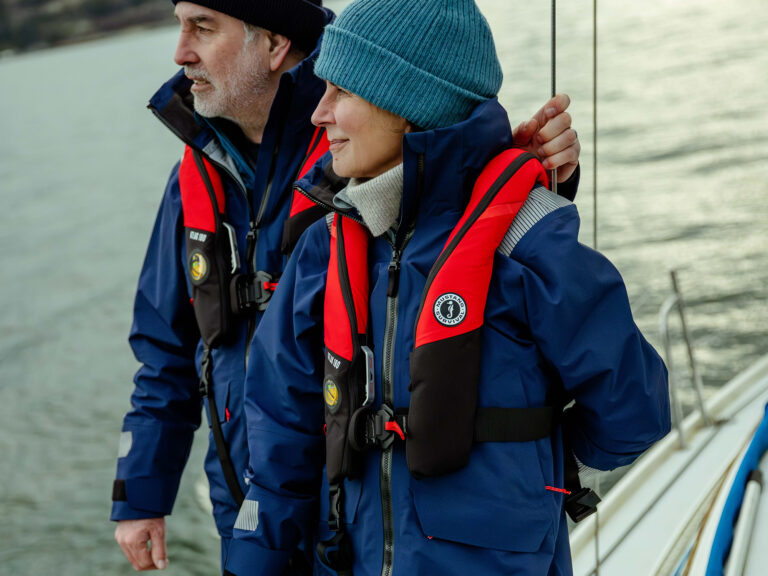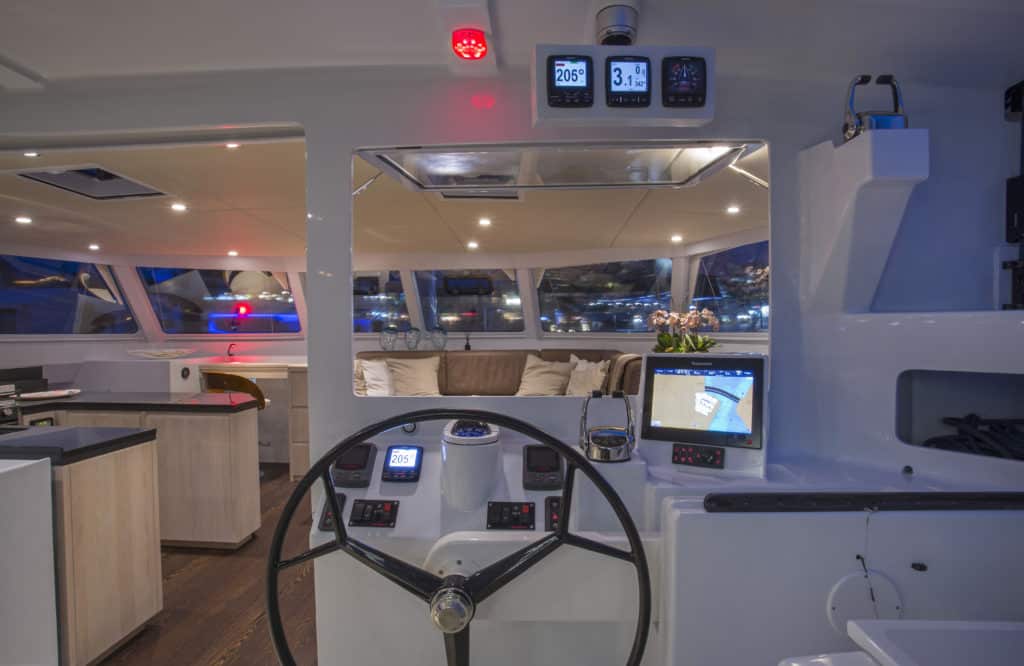
The adage goes that what’s old eventually becomes new again. While this applies to some yacht-design elements and sailhandling equipment, it does not describe the flat-out straight-line evolution in marine electronics, which become more powerful and feature-rich with every dizzying spin of the design cycle. Advances in microprocessors, solid-state componentry, and touchscreen and scanning technologies — as well as networking and software advances — enable cutting-edge innovations such as Doppler radar imagery and interdevice connectivity.
This past fall, I scoured announcements from the NMEA Conference & Expo, attended the Fort Lauderdale International Boat Show and the METS expo in Amsterdam, and consulted industry insiders to learn more about 2017’s state-of-the-art marine electronics. If you’re shopping for equipment, I’ve compiled a roundup of the latest-generation gear — sorted by manufacturer — that you’ll want to explore.
Peace of Mind from Aydin
Aydin Marine (formerly KEP) understands that vessel monitoring and security are serious concerns for plenty of sailors, and its new Seatether system offers peace of mind for those who spend considerable time away from their boats. Seatether systems (from $4,600) feature a black-box central processing module that “talks” with an expandable network of sensors that can monitor everything from doors and hatches to bilge-water levels and AC and DC power supplies, and which communicates to the outside world via a built-in cellular modem (Seatether is also compatible with third-party satellite communication systems). Users can upgrade their componentry package to include video monitoring (up to four cameras), which allows them to stream real-time video onto networked Android or Apple tablets. Additionally, users can add a night-vision camera, as well as upgraded communication and global tracking packages, which can be monitored from anywhere in the world.
Displays from B&G
B&G electronics have long been synonymous with top-end sailboat racing, but recent years have seen the brand focus more on club-level racers and cruising sailors. The company’s latest multifunction display, the Zeus3, looks as though it will please sailors of all stripes. The latest display comes in four screen sizes: 7-inch ($1,300), 9-inch ($2,300), 12-inch ($3,500) and a new 16-inch ($5,500) model. All of them feature B&G’s new Solomax HD screens, which use in-plane switching technology (i.e., technology that rearranges the liquid-crystal molecules in between the display’s layers of glass) to remove the viewing-angle deficiencies that can hamper some LCD displays. The Zeus3 features B&G’s latest touchscreen technology, which has reduced concerns about water hitting the screen and affecting fingertip control, notes Alan Davis, B&G’s product line director. Additionally, the Zeus3 incorporates a full-size hard-button keypad that can control all of the display’s functionality without using its touchscreen interface, which is convenient for rough-weather passages.
B&G’s newest displays feature processing speeds similar to the Zeus2’s and will use the same operating system; however, the devices will support B&G’s ForwardScan forward-looking sonar (as well as other sonars). The Zeus3 also incorporates all of B&G’s advanced sailing features, including SailSteer and Sailing Time, while also integrating third-party wind-forecasting information from PredictWind.
In addition to its new flagship display, B&G has also unveiled its all-glass-screen Vulcan 9 navigation display, which, says Davis, offers almost all of the same features and functionality as the older Zeus2 displays but at a fraction of the price. For example, the Vulcan 9 display ($1,050) can be used to view radar imagery or control autopilots; however, it is designed as a single-station solution, not a fully networkable plotter (for example, the Vulcan 9 doesn’t support chart or sonar sharing). The Vulcan 9 is NMEA 2000-compatible and features built-in Wi-Fi and GPS; additionally, it supports B&G’s sailing-specific features, including SailSteer and Sailing Time. Both the Zeus3 and Vulcan 9 play nicely with C-Map, Navionics, NV Digital and Insight chart kits, giving cruisers a wide range of raster and vector cartography choices.

Garmin Radar, Sonar and Displays
Garmin turned heads in early 2016 when it released its GMR Fantom 4 and GMR Fantom 6 open-array radars, which use solid-state power amplifiers and pulse-compression technology to harness the Doppler effect and graphically differentiate moving targets from stationary objects, effectively determining which underway vessels are a threat and which are not. Now Garmin has introduced its radome-enclosed GMR Fantom 18 ($1,600) and the GMR Fantom 24 ($2,800) radars. Both new sailboat-friendly models (no spinning antennas, known as “arrays,” to snag lines) offer 40 watts of transmitting power and a range of 20 feet to 48 nautical miles, as well as Garmin’s proprietary MotionScope (Doppler) technology. The Fantom 18 offers a wider beam width of 5.2 degrees, while the Fantom 24 offers a beam width of 3.7 degrees; narrow beam widths provide higher-resolution radar imagery. Additionally, both new Fantoms come with Garmin’s Dynamic Auto Gain and Sea Filter settings, which automatically adjust gain levels based on sea state and meteorological conditions. The Fantoms include 10-vessel MARPA tracking capability as well.
Realizing that forward – looking sonar can be of great benefit to sailors who are nosing into unknown harbors or inlets, or negotiating ice on high-latitude cruises, Garmin has introduced the Panoptix PS51-TH FrontVu ($1,500) through-hull transducer, a far more suitable unit for sailboats than the older-style Panoptix transducers, which were mounted to either the transom or trolling motor on fishing boats. The newest Panoptix transducer eliminates drag and uses a very narrow forward-looking beam angle, allowing you to concentrate sonar energy on what’s in front of the boat.
While touchscreen technology still snares headlines in the so-called chart-plotter wars, some sailors prefer a hard-key interface, especially when conditions get rough. Garmin’s new 1042xsv ($2,300) and 1242xsv ($3,000) chart plotters feature hard-key interfaces and support radar, forward-looking sonar, AIS, anemometers and other instrumentation, while offering the flexibility of NMEA 0183 and NMEA 2000 network compatibility and Wi-Fi connectivity, as well as an ANT wireless component to connect with sensors and other onboard equipment.
Lastly, Garmin has also released two new fixed-mount VHF radios, the VHF 110 ($280) and the VHF 210 AIS ($600). Both deliver 25 watts of transmitting power and digital selective calling, which allows a user to make direct calls to other vessels or, should calamity strike, place multivessel distress calls. The VHF 210 AIS also includes a listen-only Automatic Identification System receiver to help bolster situational awareness of other nearby vessels.
Slim and Trim from Icom
Icom, no stranger to the marine radio market, has unveiled its new IC-M93D, which it describes as the “world’s slimmest floating DSC radio.” While I didn’t have a measuring tape handy, the IC-M93D ($350) certainly felt like a tightly crafted wireless VHF when I handled it at the Fort Lauderdale International Boat Show. The svelte radio boasts a 2.3-inch dot-matrix LCD screen that’s purportedly easy to read in direct sunlight. The radio has a soft-key user interface that features a four-way directional keypad, and DSC calling capability that monitors channel 70 for emergency DSC signals. There’s also a dedicated distress button that can trigger man-overboard alarms and broadcast them to all DSC-equipped vessels within VHF range. An integrated GPS provides location information (including speed and bearing data) and allows you to navigate from waypoint to waypoint, while noise-canceling technology helps ensure clear communications.
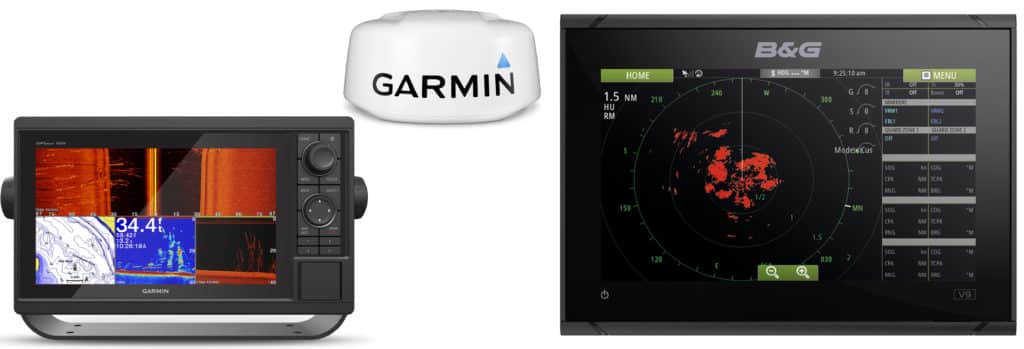
Cameras from Iris
Iris Innovations has been a disruptor in the thermal-imaging-camera market for several years with extremely cost-competitive models (including networkable cameras, thermal imagers and underwater cameras). Now, with the announcement of its new iHD technology, the U.K.-based firm has turned its attention to high-resolution daylight cameras, which will be featured on 2.0 versions of many of the company’s bestsellers, as well as on new models under development. The new iHD cameras deliver 1,920-by-1,080-pixel resolution and real-time performance, and they feature a plug-and-play network interface, making them a consideration for cruisers who want to bolster onboard security or have a better idea about what’s unfurling topside.
At present, the iHD cameras are compatible with Garmin’s 84xx and 86xx displays and Raymarine’s gS195 displays, as well as with PC-based navigation systems and other types of displays that feature HDMI, HD-SDI or DVI inputs.
Raymarine Software, Plotter Upgrades
Raymarine has been focusing on software updates, including a big upgrade to its EV1 solid-state compass, which can be used as a stand-alone compass or as part of Raymarine’s Evolution autopilot system. The company has also refined the LightHouse navigation operating system to offer more functionality and operational flexibility.
On the hardware side of the business, last summer Raymarine brought out the i70s instrument display ($480), and we got a first glimpse of it at the fall shows. On first glance, the sharp-looking purpose-built screen did not disappoint.
The i70s offers a sleek design that nicely complements the aesthetics of Raymarine’s eS and gS plotters, and features a weatherproof 4.1-inch optically bonded screen. Raymarine’s latest instrument display boasts bright colors, crisp contrasts and a simple four-button user interface. The i70s can be networked with Raymarine plotters to display customizable navigation data, such as depth, speed and wind information, or it can be networked directly to compatible sensors, such as an anemometer, or to other i70s displays to create a stand-alone network. When used in conjunction with a Raymarine iTC-5 instrument transducer (sold separately; $265), the i70s can also display information from analog instruments and transducers (e.g., rudder-angle indicators). Additionally, the display can serve as an AIS repeater, which is especially handy if the vessel’s main plotter is fitted belowdecks.
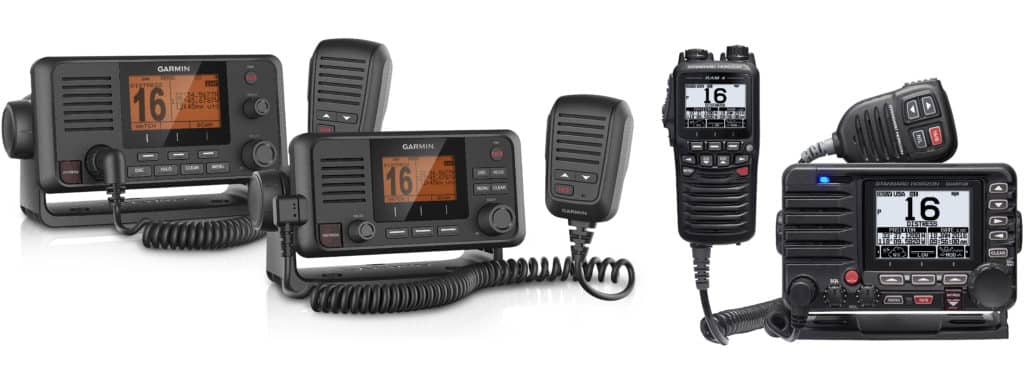
Options from Standard
Standard Horizon has long been a trusted name in marine VHF radio communications, and the new Quantum GX6500 appears to be appropriately christened. The radio makes a bold leap forward by combining several normally stand-alone technologies into one can-do unit. At its core, the GX6500 features a 66-channel VHF with built-in GPS; it can send and receive Class B AIS data and share both AIS and DSC data with the vessel’s navigation system via an NMEA 0183 or NMEA 2000 backbone. Additionally, the fixed-mount VHF can be paired with up to five Standard Horizon RAM4W wired or wireless mics, and it sports a dual-zone 25-watt loudhailer that features listen-back and fog signals. The unit has a dedicated NMEA 2000 port as well as two kinds of voice scrambling for sensitive or private conversations.
Standard Horizon is also expected to release the Quantum GX6000, which shares the same features as the GX6500 but uses a listen-only AIS receiver. Both the GX6500 and the GX6000 rely on dual antennas (one for VHF, one for AIS), which adds some installation complication but should help ensure that communications are never missed.
As of this writing, both the GX6500 and the GX6000 were awaiting FCC approval. Once this is granted, the radios are expected to retail for $800 and $500, respectively.
Weego Takes Charge
In researching new gear that should make an appearance at this winter’s and spring’s boat shows, I came across another item worth mentioning.
Weego understands that without power, most modern sailboats don’t leave the anchorage. Recognizing that dead batteries can ruin the day, the company has introduced a new line of portable power solutions designed to give your boat (or smart device) a jump-start. Weego’s product line includes the jump-start-only Weego 22S ($75), as well as the Weego 22 ($100), Weego 44 ($150) and Weego 66 ($200). The Weego 22, 44 and 66 units all include a USB charger, which provides a fast charge for devices like cellphones and tablets, while also featuring an IP65 weatherproof rating and a built-in flashlight. The new portable chargers rely on lithium-polymer batteries and include Weego’s patented Smarty Clamps jump-start system; the Weego 44 and 66 batteries also feature 12- and 19-volt outputs.
David Schmidt is CW’s electronics editor.




